I wrote the previous post a month ago, but only posted it today. I’ve been writing this one (much too long — only my children will read all of it) for the past week or so.
The field must have been pasture once, and it’s bordered on the south side by a stone wall. Not long after moving onto this land, we removed old barbed wire from along the wall and from along the trees (often swallowed up in their trunks) that used to frame the high end of the pasture to the west. There was a time when the woods themselves were pasture quite high up the mountain, where I have come across barbed wire that now runs through the center of large trees. There were probably Merino sheep here during Vermont’s wool boom in the early 19th century. Before that time, my field had been cleared of stones so that it could be planted or hayed. Did oxen drag a plow though my field?
In the 1920s or 30s, perhaps as a CCC project during the Depression, our 1.5 acre field was planted to red pines, in long, regular rows. Those are the trees that ended up in our log cabin (they gave us the idea) up the slope on this shelf of land where I am writing in this house. We had the pines that remained logged off for pulp, and the area was then bulldozed and the stumps buried or pushed into a heavyweight brush pile in the center. The area was then planted with ‘conservation mix’ grasses, which grew into a pretty field. We hit a baseball down there once or twice. I tried a row of sunflowers, but drought and deer did them in. Blackberries sprang up, but we let them grow in exchange for the berries. Then we left for Greece and old field succession has been in progress ever since. On at least one occasion, on a flying landlord visit from Greece, I took my chainsaw to the biggest white pines and some of the hardwoods that had come in along the driveway, but I had to watch the other trees – poplar, ash, pignut hickory, black cherry, white birch, red oak, buckthorn, sumac – gro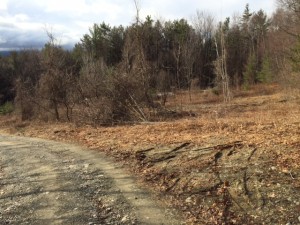 w tall and the vines climb up them and take over in much of the field.
w tall and the vines climb up them and take over in much of the field.
The stones were probably piled in the wall around 1800 or a bit later, when the land around here had been settled (very sparsely at first) for only 35 or 40 years. The forest might have even been burned for coke. But all that clearing! Giants in the Earth! I look upon myself like that now when I think that I cut down those towering red pines and built the cabin with Holly, a crew of Bennington students, and on a few occasions with the help of friends and my father. But the stones: I have been dragging brush in the footsteps of those who dragged the stones – or rather, who stepped alongside the horse or ox dragging the stones in a stone boat. Men work together, says Frost. I added a couple of good-sized stones to the wall myself last week. I rolled them to my car and up and down a board ramp onto the wall.
The field was not the most urgent matter when I returned last fall, but I managed one foray, knocking down some large poplars and a few birches and oaks. I scythed a wide path along the west side of the field at the end of June this year to make it possible to venture in (and along that path the fringed gentians grew), but the enormity of the work of clearing weighed on me. It would have been an expensive proposition to call in the landscapers with their chainsaws, chippers, mowers and men. Some of the trees that had been growing for 20 years were 30 feet tall or more, and were covered in twisting, grasping swaths of grape vines, tough, shrubby honeysuckle, strangling bittersweet, buckthorn studded with nails, and Japanese barberry with its vicious canes of clinging, piercing, ripping thorns. But three weeks ago I put on my Kevlar chaps and waded in to wage war on woody vegetation and vines, with Stihl saw in hand and fierce countenance. If you go through one tank a day for a week, things begin to look different. Then it’s just a matter of cleanup: hand to hand combat until I could call in the machine, a field mower that you drive like a tiller and that makes a beautiful sound as it cuts and chops with one powerful rotary blade. In short, I won the battle for the field. It was larger than I remembered it, but two thirds of it has now been cleared to stubble.
I should mention that in August the Bennington County Forester came (at my invitation) and told me that my field was full of invasive species and that transporting bittersweet across state lines (or anywhere?) is against Vermont law. I had had visions of a lucrative bittersweet plantation, since the berries are prized in wreaths and as harvest decorations. I imagined supervising tables manned by women (so to speak) processing my bittersweet for the New York market. I could have packed my wagon (my station-wagon-style Subaru, that is) with wreaths and sprays and driven to the city (at night), running fresh Vermont Asiatic bittersweet to an immense garden shop in Yonkers or a street corner in Brooklyn for big money.
I don’t know what I will do with the field when I am done except keep out the forest and get rid of the invasive vines. Then: a hardwood plantation? A hickory grove, for instance? The soil is fertile and there is water underneath it. Spring runoff from the brook flows in two channels through it and in underground channels as well. If not hardwoods, fruit trees? An apple orchard? Plums, pears, cherries? Kiwis! A hardy kiwi plantation started with cuttings from my prolific vines beyond the garden (“put up ten quarts this year and gave quantities away”). I would train the kiwi vines on wires to have all the fruit at easy harvest height and become the Kiwi King. Alternatively, I could just keep harvesting my no-maintenance two vines out back and forget about the whole idea – it sounds like a lot of work. Or perhaps I should just try to grow fringed gentians, which love wet meadows, for their beauty, their memories (Holly discovered them on the high side of the driveway long ago), and their good name in poetry:
Thou waitest late and com’st alone,
When woods are bare and birds are flown,
And frosts and shortening days portend
The aged year is near his end.
Then doth thy sweet and quiet eye
Look through its fringes to the sky…
— Bryant
I walked the field again this afternoon. Even now there are more impenetrable nests of vines and thick sprays of invasive shrubs in the declivities and around the ancient brush piles, now rotted and mossy and covered with vines, and impossible to mow. There will still be patches of chaos even if I win a second and third round in my struggle. I must prepare the way of the bush hog (not mine, the one I will hire annually once the initial subduing is done), then never return!
Here are two pictures from the action. The colors temporarily arrested my attack.

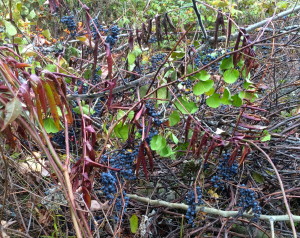 I harvested the grapes and will feed them to wildlife this winter. I’ll still leave some in the new field. Besides, the owls will have wonderful hunting, and they are my year-round companions in these woods. Hawks too pass overhead; we used to have to have a tent-like chicken-wire roof over our chicken yard to protect against their raids. The Redtails will hunt the field by day, the Barred Owls by night. We top predators stick together.
I harvested the grapes and will feed them to wildlife this winter. I’ll still leave some in the new field. Besides, the owls will have wonderful hunting, and they are my year-round companions in these woods. Hawks too pass overhead; we used to have to have a tent-like chicken-wire roof over our chicken yard to protect against their raids. The Redtails will hunt the field by day, the Barred Owls by night. We top predators stick together.
I have walked the woods with two County Foresters, the first in 1985, the second in 2015. I remember the first, Jim White, telling me of the fertility of the soil here and encouraging me to treat the woods “like a garden.” Of course, I have been able to do almost no proper forest management – the weeding out of undesirable trees, for example – and have simply watched the garden grow, or rather, been struck by how much it has grown since 1983, when I first beheld it as middle-aged second-growth woods.
I was recently reading a 2007 lecture by Richard Smith on Thoreau’s first year at Walden Pond, which contains the following:
After purchasing about fourteen acres of land at the Pond in 1844, Emerson became quite attached to his new holdings. He called the woodlot “my Garden” and wrote to Thomas Carlyle that his new land holding was “the best plaything I ever had.” Emerson, along with his family, made frequent, almost daily excursions to the woodlot… Historian Barksdale Maynard says that the woodlot was “a central feature of Emerson’s life.”
[Emerson permitted Thoreau to build a small house on this land]. Maynard continues:
That first year, Thoreau was expected to make some improvements while at the Pond, the main chore being to clear the land of overgrown shrubs and brambles. Ellery Channing called the land Thoreau lived on “The Briars,” and the place where Thoreau planned to plant his beans was a fairly wild, tangled area. In exchange for rent, Thoreau set to work clearing some of the land about a month before moving into his house on July 4, 1845.
Thoreau was in his 20s, and I am in my 60s, but I see we have both been clearers of brambles. Thoreau cleared an area of about two and a half acres. My field is about one and a half acres. My house clearing higher up is one acre or so. I’m not going to clear every last bramble and vine in my field, and I do not expect to be planting beans. Or collecting the briar canes, either, charming though the lines from Herrick on his house are:
Some brittle sticks of thorn or briar
Make me a fire,
Close by whose living coal I sit,
And glow like it.
I do sit by my own woodstove, however, and glow in the orange glow from its fanlight glass. What for Herrick was fuel barely passes for kindling in Vermont, but I have burned a thorny dry cane or two on occasion to start a fire.
I have been reading A Week on the Concord and Merrimack Rivers lately, which was Thoreau’s first book and the one he went to Walden to write. One passage near the beginning rallied me to my field project. Thoreau is ruminating about the sights he and his brother (his companion on this trip) will see, and Thoreau imagines the men whom they will see waterfowling, or working outdoors, as they pass by in their boat, “men fuller of talk and rare adventure in the sun and wind and rain than a chestnut is of meat,” veterans of the Revolutionary War and the War of 1812 who “have been out every day of their lives” and are “greater than Homer or Chaucer or Shakespeare, only they never got time to say so. They never took to the way of writing.” But they did not lack for material, says Thoreau. “Look at their fields, and imagine what they might write.” Like Virgil’s farmers unaware of their good fortune, these men don’t know the epics they would have written had they taken to writing instead of wringing their living heroically from the land. The next step follows: “What have they not written on the face of the earth already, clearing, and burning, and scratching, and harrowing, and plowing…” The fruits of their labors as settlers and farmers constitute their collected works.
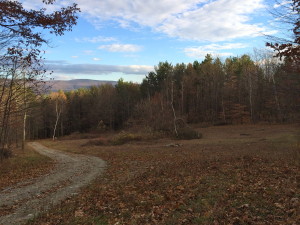 I asked a friend of mine from Norwich, Vermont, who settled on a piece of woodland forty years ago, ten years before we did, if he had been doing anything creative lately. He said he had been working on his property, which includes his homestead, outbuildings, a sugar house, gardens, orchards, clearings, woods, trails, and chickens. This was his poetry, and it is (in part) mine as well. Most people, most Vermonters, anyway, find creative outlets in gardening, landscaping, or in any number of outdoor hobbies and projects on their property.
I asked a friend of mine from Norwich, Vermont, who settled on a piece of woodland forty years ago, ten years before we did, if he had been doing anything creative lately. He said he had been working on his property, which includes his homestead, outbuildings, a sugar house, gardens, orchards, clearings, woods, trails, and chickens. This was his poetry, and it is (in part) mine as well. Most people, most Vermonters, anyway, find creative outlets in gardening, landscaping, or in any number of outdoor hobbies and projects on their property.
For Thoreau himself, manual labor and written reflection sustain each other. In fact, he says, the former even exercises a salutary influence on prose style:
“If he has worked hard from morning till night, though he may have grieved that he could not be watching the train of his thoughts during that time, yet the few hasty lines which at evening record his day’s experience will be more musical and true than his freest but idle fancy could have furnished.” He writes “the tougher truth for the calluses on his hands.” The scholar should emulate the farmer’s call to his team “and confess that if it were written it would surpass his labored sentences.” Thoreau elaborates and extends this idea for a full page; for all his hoeing and wood chopping, his own style is not always as direct and unadorned as he imagines when he compares the pen to the plow. But his idea that it is the energy of the body that stimulates the mind may help to explain how the man who cleared brush and raised seven miles of beans and took vigorous walks all over Concord managed to write several books and two million words in his journal in less than twenty years.
I mentioned Mount Greylock in a previous post. I have a view of the summit from an elevated point near my house, thanks to some recent clearing. I drove to the top of the mountain many years ago, but I don’t remember much of anything. I have seen the view of the summit from Melville’s north-facing piazza at Arrowhead, but now I have a new view of the mountain, and it is of young Thoreau bushwhacking up the side of it in July, 1844, and spending the night on the summit using some boards for a covering (quite comfortable, said the Spartan adventurer). There were already trails in those days, but Thoreau chose a more direct but unpathed route through the woods, despite a warning from the man who saw him begin his ascent. He reflects that travellers often exaggerate the difficulties of the way, which he says are largely imaginary:
“For what’s the hurry? If a person lost would conclude that after all he is not lost, but standing in his own old shoes on the very spot where he is, and that for the time being he will live there; but the places that have known him, they are lost—how much anxiety and danger would vanish… Who knows where in space this globe is rolling? Yet we will not give ourselves up for lost, let it go where it will.”
In other words, live where you find yourself, and think of the world, not yourself, as lost. This passage prefigures a better known but more abstract one from Walden, also about getting lost in the woods, or perhaps the cosmos:
“Not till we are lost, in other words not till we have lost the world, do we begin to find ourselves, and realize where we are and the infinite extent of our relations.”
Thoreau carried no water and no tent up Mount Greylock, but he had a compass, and used it to get to the summit of the mountain at dusk. There was a crude observatory at the top, the source of the stray boards that Thoreau bedded down on, in, and under, since he seems to have improvised a sort of coffin-like pod for himself:
“But as it grew colder towards midnight, I at length encased myself in boards, managing even to put a board on top of me, with a large stone on it, to keep it down, and so slept comfortably.”
It seems he rested in peace (complete with stone to mark his place). The charm of Thoreau is in the “so” of “and so slept comfortably.” Of course he slept comfortably, as any man would, lying on a board under another board, the top board held down with a stone, without a blanket on a mountaintop at night. And yet now when I look south from this spot I will indeed think of him as sleeping comfortably, in his way – and what he says about the pleasure of moderate weight on the body is very true – think of the pleasure of the lead vest at the dentist’s – up there, or greeting the dawn above the clouds, as he does on waking, the next time I view the summit of Mount Greylock.
Thoreau! You thought of your house by the Pond as a mountain house.
http://www.walden.org/documents/file/Library/Thoreau/writings/Writings1906/07Journal01/Chapter7.pdf
And to conclude with one of Henry’s stranger reflections: “Toward evening, as the world waxes darker, I am permitted to see the woodchuck stealing across my path, and tempted to seize and devour it. The wildest, most desolate scenes are strangely familiar to me.”
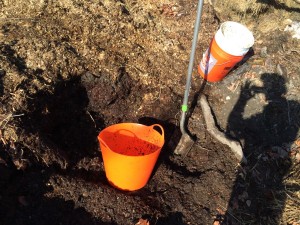
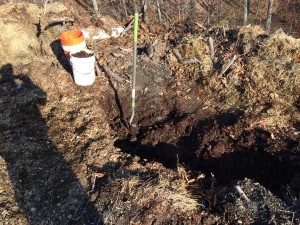
 w tall and the vines climb up them and take over in much of the field.
w tall and the vines climb up them and take over in much of the field.

 I asked a friend of mine from Norwich, Vermont, who settled on a piece of woodland forty years ago, ten years before we did, if he had been doing anything creative lately. He said he had been working on his property, which includes his homestead, outbuildings, a sugar house, gardens, orchards, clearings, woods, trails, and chickens. This was his poetry, and it is (in part) mine as well. Most people, most Vermonters, anyway, find creative outlets in gardening, landscaping, or in any number of outdoor hobbies and projects on their property.
I asked a friend of mine from Norwich, Vermont, who settled on a piece of woodland forty years ago, ten years before we did, if he had been doing anything creative lately. He said he had been working on his property, which includes his homestead, outbuildings, a sugar house, gardens, orchards, clearings, woods, trails, and chickens. This was his poetry, and it is (in part) mine as well. Most people, most Vermonters, anyway, find creative outlets in gardening, landscaping, or in any number of outdoor hobbies and projects on their property.